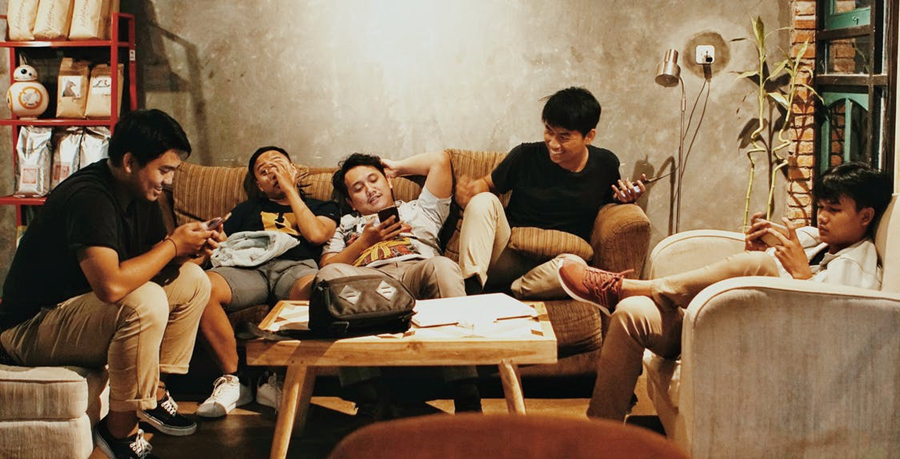7.1: Making Friends
- Page ID
- 152958
SOURCE: https://www.pexels.com/photo/men-sits-of-sofa-1036804/
CREDIT: Afta Putta Gunawan/Pexels

Thus far, we’ve studied the basics of interpersonal communication. Now, for the second half of this course, we’re going to study the application of these principles. The next three chapters are devoted to intimate relationships – getting along with people, making friends, and love and marriage. The final three chapters will focus on getting a job, communicating with others in the workplace, and leading others in the workplace.
Let’s start with a clip from a Broadway musical, “South Pacific.” The show premiered in 1949 and ran for 1,925 performances. It was based on James A. Michener’s Pulitzer Prize-winning book, Tales of the South Pacific.
The plot centers on an American nurse stationed on a South Pacific island during World War II, who falls in love with a middle-aged expatriate French plantation owner but struggles to accept his mixed-race children. A secondary romance, between a U.S. Marine lieutenant and a young Tonkinese woman, explores his fears of the social consequences should he marry his Asian sweetheart. Here’s a clip from the 1958 film version:
Happy Talk – South Pacific
The clip illustrates one of the essential truths of friendship—we like to be around people who are fun, and who make us happy. It’s the quality and variety of friends that matters – not the number, despite what Facebook might want us to believe. And it’s necessary to have some friends who aren’t just like us. People with varied relationships have better physical and mental health. These friends help them moderate different moods, a concept some call emotionships. (Cheung, Gardneer & Anderson, 2014)
You have probably experienced this yourself. You may have one set of friends to whom you turn for support in reaching your fitness goals. Another set for support in studying for a math class. Still another to help you practice for a speech class. Still another when you’re having a really bad day. The reason this is effective is that any one individual may not have the ability to meet the majority of one’s emotion-regulation needs.
This seems to be particularly true in cases of marital disruption (death, divorce), perhaps because women maintain more diverse support networks than men, who often rely on their spouses as their only confidant (Kiecolt-Glaser & Newton, 2001).
In Chapter 6.2, we discussed proxemics, the idea that 18 inches to four feet is our most intimate zone, 18 inches to four feet is our personal space, four feet to 12 feet is our social space and beyond 12 feet is our public space. Much the same concept holds true when it comes to friendships. Friendships also shift themselves into concentric circles, like a bull’s eye. In the center is our ‘support clique,” about five people who would unstintingly give you support or help if you needed it. The next ring, of about 15 people, is your “sympathy group,” whom you invite for a quiet dinner or evening at the pub. Then about 50 “good friends,” until finally, you reach 150, Dunbar’s Number or the upper limit of friends you can have, and eventually 500, acquaintances you know through work or a social group but who are “unlikely bother turning up to your funeral.” (Dunbar, 2021).
For friendships to survive, they need personal interaction. From data collected from women’s social networks in Britain and Belgium, Dunbar concluded that we devote 40% of our social time to the five people in the innermost layer and 20% to the 10 people that make up the rest of the next layer. The remaining 135 get what’s left over – “about a half minute a day.”
Let’s think about building your dream team of friends. Who would you include?
· Co-workers, who can help you understand how things really work at your place of work.
· Neighbors, so you have a sense of community
· People who share your hobbies and interests.
· Friends you can learn from, who are different from you, who know something you don’t. Those friendships can expand your world.
· Friends in the same life stage as you. Are you a new parent? Recently divorced? Received a diagnosis of diabetes? You need people who can understand and relate.
References
Cheung, E.O., Gardner, W.L., and Anderson, J.L.(2014). Emotionships” Examining people’s emotion-regulation relationships and their consequences for well-being. Social Psychology and Personality Science p.1-8. Doi:10.1177/1948550614564223
Dunbar, R. (2021). Friends: Understanding the power of our most important relationships. Little, Brown UK, cited in Pinker, S.(2022, March 10). ‘Friends’ review: People you can count on. The Wall Street Journal. https://www.wsj.com/articles/friends...article_inline
Kiecolt-Glaser, J. K., & Newton, T. L. (2001). Marriage and health: His and hers. Psychological Bulletin, 127, 472–503. doi:10.1037/0033-2909.127.4.472

